Sometime in the 1990s, the three Khans of Bollywood carved out unique niches for themselves in the mainstream cinema sphere as the whole world watched. Shah Rukh took up the mantle of the King of Romance, Salman was the fighter, not a lover. And then there remained Aamir. In an industry that has shirked on reinvention in recent years, few actors have capitalised on the art of transformation quite like Aamir Khan. He has positioned himself as Bollywood라이브 바카라 most methodical and intellectual star—the merits of which can be debated because among a filmography dotted with spectacular hits, there have been the most inexplicable duds.
Aamir Khan: The Rise And Reckoning of Bollywood라이브 바카라 Perfectionist
From his early years as a fresh-faced romantic hero to his transformation into a thinking-man라이브 바카라 superstar, the auteur-performer Aamir Khan라이브 바카라 career has been marked by a restless pursuit of perfection and reinvention.
Over a career spanning more than three decades, Khan has reigned as a box office titan. And to celebrate Khan라이브 바카라 60th birthday, PVR Inox will be re-releasing more than 20 of his most memorable films across theatres all over India. He has worked on more than fifty projects, either in his capacity as a performer, producer, screenwriter, or director.
At a time when Bollywood is increasingly aligning with nationalist narratives and India's socio-political climate is marked by rising Hindutva radicalism, Aamir Khan still represents a counterpoint—a Muslim superstar who has consistently championed socially conscious, humanist storytelling. However, his recent career choices—the expensive Thugs of Hindostan (2018) and Lal Singh Chaddha (2022)—have raised questions about his ability to evolve. His long gaps between films suggest an artist unsure of his place in an industry that has moved beyond the traditional Bollywood star system.

His films, from Sarfarosh (1999) to PK (2014) to Dangal (2016), have often questioned systemic injustices, religious orthodoxy, and rigid nationalism. Veteran lyricist-screenwriter Javed Akhtar praised the actor while announcing the ‘Aamir Khan: Cinema Ka Jadugar’ film festival, “Aamir takes chances, no other can.” While this sentiment is valid, Khan라이브 바카라 own belief in him being a changemaker has often resulted in The Messiah Complex. With the projects with social messages, while his intentions may be noble, there라이브 바카라 always an underlying patronising tone in his work that suggests a “savior complex”. His films often present solutions in simplistic, digestible ways, reducing nuanced social issues into feel-good resolutions.
Taare Zameen Par (2007), PK (2014) as well as Dangal (2016) ultimately centres his character. In Taare Zameen Par, he is the benevolent outsider who single-handedly “saves” the child. Dangal was about the Phogat sisters, but the emotional core remained Mahavir Singh Phogat라이브 바카라 struggle. The daughters’ victories were tied to their father라이브 바카라 vision, not their own ambitions. Khan made headlines for his dramatic weight gain to portray Phogat—an effective exercise in authenticity in an era when the other Khans rely on CGI for chiseled abs and digital de-aging—but it overshadowed the feminist core of the film as the male perspective dominated.
Khan's reliance on being considered one of Bollywood라이브 바카라 most intelligent actors and his socially aware image has also backfired in recent years. This intelligence has not always equated to artistic boldness. His career is a paradox—visionary yet formulaic, progressive yet constrained, ambitious yet risk-averse.

The Birth of the 'Chocolate Boy' Hero
Khan made his debut as a child artist in his uncle Nasir Husain라이브 바카라 Yaadon Ki Baaraat (1973). But it wasn’t till 1983 when he acted and assisted on Aditya Bhattacharya라이브 바카라 experimental short film Paranoia that he felt truly inspired to pursue a career in movies. Like most Indian parents, his also wanted him to seek out something more stable. He made his feature film debut with a small role the next year in Ketan Mehta라이브 바카라 experimental student film Holi.
However, it was his cousin Mansoor Khan라이브 바카라 directorial debut, Qayamat Se Qayamat Tak (1988), which was written and produced by Husain, that truly kickstarted Khan라이브 바카라 career. At a time when launching a new star kid was considered more exciting than triggering, Qayamat Se Qayamat Tak (QSQT) disrupted the trend of films that were dominated by themes of revenge, corruption, and social justice. The brooding and rugged angry young man made way for the 'Chocolate Boy'—more sensitive, youthful, and boyishly charming.
Along with reviving musical romance as a bankable genre, QSQT paved the way for how newcomers could be marketed and turned into bankable stars without relying on established stars or action-heavy storytelling. But before committing himself to his romantic era—which saw landmark hits like Dil (1990), Jo Jeeta Wohi Sikandar (1992), and Raja Hindustani (1996), Khan explored the action genre with the 1989 crime drama Raakh. The film earned him his first of four National Awards. However, despite being a financially secure nepo kid, around this decade, Khan also chose to pick up bafflingly bad projects like Awwal Number (1990) and Daulat Ki Jung (1992).

The Rise And Reckoning Of The Auteur-Performer
After a successful run as a romantic hero, who also excelled in comedy—from Andaz Apna Apna (1994) to Ishq (1997)—Aamir Khan shifted gears, embracing a new kind of cinema where he wasn’t just a star but a brand in himself. The year 2001 was a significant one. Along with Dil Chahta Hai, which saw him in a new metropolitan avatar, Khan also launched his own production house. His production라이브 바카라 debut film Lagaan became only the third ever Indian film (after Mother India and Salaam Bombay) to be nominated for the Academy Award for Best Foreign Language Film. It went on to win eight National Film Awards as well.
Barring the failures of Mangal Pandey: The Rising (2005) and Fanaa (2007), Aamir Khan seemed unstoppable in the noughties. From the critical and commercial success of Rang De Basanti (2006) to masala hits like Ghajini (2008) to the socially-driven era with films like Taare Zameen Par, 3 Idiots (2009), and PK, a new dawn had been ushered into Khan라이브 바카라 career. He also produced several commercial and critical hits under his banner—from Peepli Live (2010) to Laapataa Ladies (2023).
When the Khans pivoted to television, the other two chose to host glamorous game shows. However, Aamir used his platform to host the talk show Satyameva Jayate (2012-2014), a show that focused on sensitive social issues from female foeticide, toxic masculinity, and domestic violence to untouchability and LGBTQI+ stories. Khan built a brand image defined by strategic risk-taking.

Despite being involved in Satyamev Jayate (his social issues TV show), he has largely stayed silent on contemporary Bollywood라이브 바카라 nepotism debates, #MeToo allegations, or the plight of political prisoners. His critique of intolerance, while significant, lacked sustained engagement. Unlike truly radical artists, Khan has been careful not to alienate the masses too much. Of course, given India라이브 바카라 precarious political climate, a mainstream actor cannot afford to be more outspoken without jeopardising their careers.
Lal Singh Chaddha, despite being an ambitious remake of Forrest Gump (1994), felt outdated in both its storytelling and execution. He positioned himself as Bollywood라이브 바카라 foremost auteur-performer, meticulously shaping his filmography and an almost obsessive commitment to perfection that earned him the moniker of ‘Mr Perfectionist’. And over the years, Khan has stepped on more than a few toes in pursuit of consciously curating his calculated brand image. His fallout with Amole Gupte and subsequent controversy over directorial credit for Taare Zameen Par is one of the most public displays of this ruthlessness. One might argue that this is the price you pay for carving out a distinct identity in an industry that thrives on conformity, however this is also an attribute that has both defined his brilliance and limited his adaptability.
The fault lines began to appear soon after the biggest commercial success of his career, Dangal. Khan took a one-year sabbatical following the box office failure of Laal Singh Chaddha (2022) right on the toes of Thugs of Hindostan (2018). However, he is in no hurry to retire into the sunset despite his recent considerations to do so. In an interview with The Hollywood Reporter India, Khan mentioned how he wants to make his “last 10 years the most productive.” He wants to support talents he believes in, from writers to directors. “I want to become a platform for talents I believe in before I retire at 70.”

Khan라이브 바카라 recent setbacks suggest that audiences may no longer be as responsive to his brand of filmmaking. Yet, his willingness to reflect, recalibrate, and mentor emerging talent signals that his impact on Indian cinema might be far from over. Khan can become a guiding force for the next generation of storytellers; something Bollywood so desperately needs right now. However, the question ultimately isn’t about what Aamir Khan has achieved, but whether he can still be the game-changer he was once believed to be.
Debiparna Chakraborty is an independent Film, TV and Pop Culture journalist who has been feeding into the great sucking maw of the internet since 2010.
